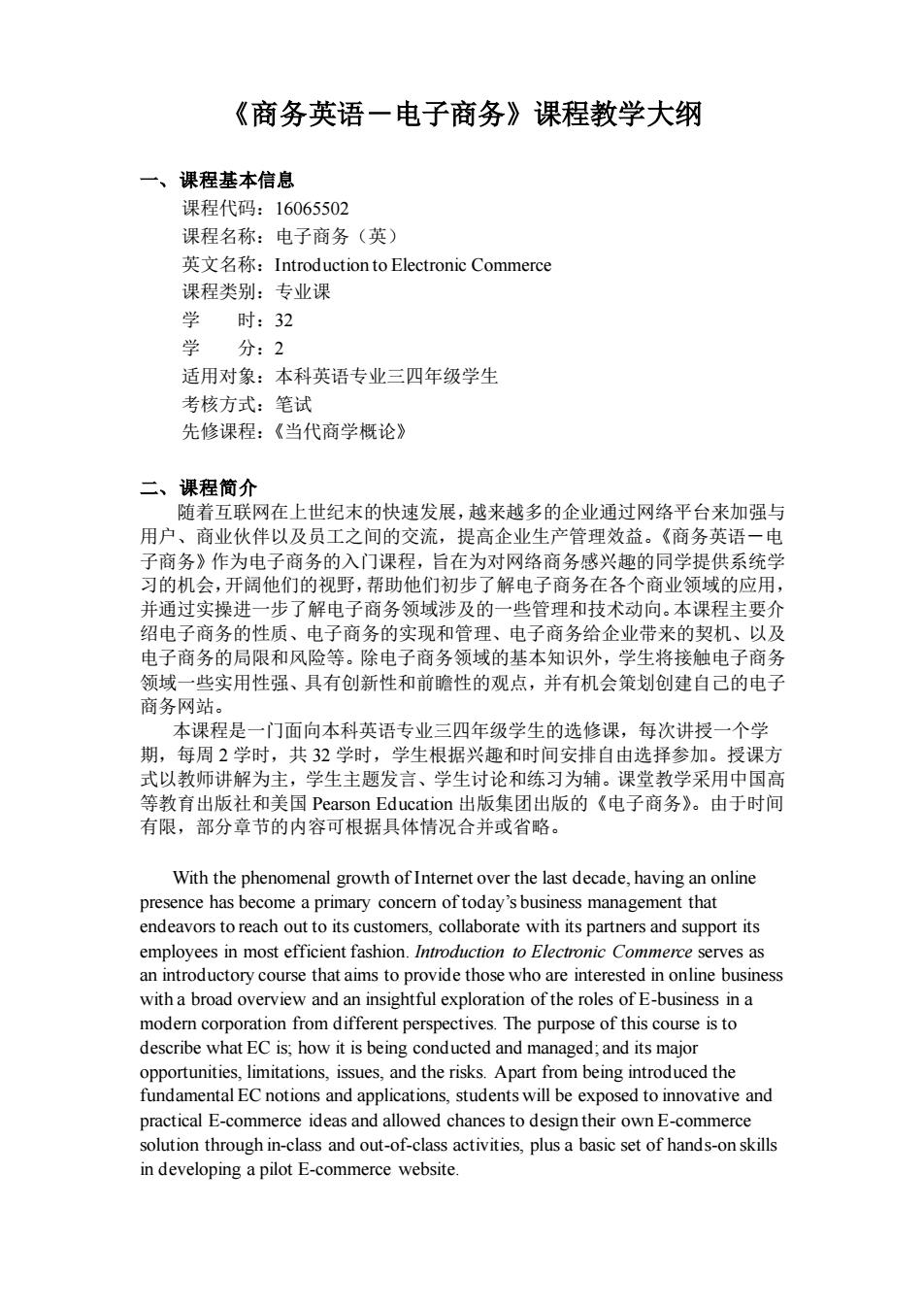
《商务英语一电子商务》课程教学大纲 一、课程基本信息 课程代码:16065502 课程名称:电子商务(英) 英文名称:Introduction to Electronic Commerce 课程类别:专业课 学时:32 学分:2 适用对象:本科英语专业三四年级学生 考核方式:笔试 先修课程:《当代商学概论》 二、课程简介 随着互联网在上世纪末的快速发展,越来越多的企业通过网络平台来加强与 用户、商业伙伴以及员工之间的交流,提高企业生产管理效益。《商务英语 由 子商务 作为电 务 入门误 ,旨在为对 网络商务感兴趣的同学提供系统学 习的机会,开阔他们的视野,帮助他们初步了解电子商务在各个商业领域的应月 并通过实操进一步了解电子商务领域涉及的一些管理和技术动向。本课程主要介 绍电子商务的性质、电子商务的实现和管理、电子商务给企业带来的契机、以及 电子商务的局限和风险等。除电子商务领域的基本知识外,学生将接触电子商务 领域一些实用性强、具有创新性和前瞻性的观点,并有机会策划创建自己的电子 商务网站 本课程是一门面向本科英语专业三四年级学生的选修课,每次讲授一个学 期,每周2学时,共32学时,学生根据兴趣和时间安排自由选择参加。授课方 式以教师讲解为主,学生主题发言、学生讨论和练习为辅。课堂教学采用中国高 等教育出版社和美国】 n出版集团出版的《电子商务》。 由于时间 有限,部分章 的内容可根据具体情况合并或省略 With the phenomenal growth of Internet over the last decade,having an online enderv routom fn marageml that rs collaborate with its partners and support its employees in most efficient fashion.Introduction to Electronic Commerce serves as an introductory course that aims to provide those who are interested in online business with a broad overview and an insightful exploration of the roles of E-business in a modem corporation from different perspectives.The purpose of this course is to describe what EC is how it is being ed an d m and its smajor opportunities,limita ons,I sues,and the risks.Apart from being introduced the fundamental EC notions and applications,students will be exposed to innovative and practical E-commerce ideas and allowed chances to design their own E-commerce solution through in-class and out-of-class activities,plus a basic set of hands-on skills in developing a pilot E-commerce website
《商务英语-电子商务》课程教学大纲 一、课程基本信息 课程代码:16065502 课程名称:电子商务(英) 英文名称:Introduction to Electronic Commerce 课程类别:专业课 学 时:32 学 分:2 适用对象:本科英语专业三四年级学生 考核方式:笔试 先修课程:《当代商学概论》 二、课程简介 随着互联网在上世纪末的快速发展,越来越多的企业通过网络平台来加强与 用户、商业伙伴以及员工之间的交流,提高企业生产管理效益。《商务英语-电 子商务》作为电子商务的入门课程,旨在为对网络商务感兴趣的同学提供系统学 习的机会,开阔他们的视野,帮助他们初步了解电子商务在各个商业领域的应用, 并通过实操进一步了解电子商务领域涉及的一些管理和技术动向。本课程主要介 绍电子商务的性质、电子商务的实现和管理、电子商务给企业带来的契机、以及 电子商务的局限和风险等。除电子商务领域的基本知识外,学生将接触电子商务 领域一些实用性强、具有创新性和前瞻性的观点,并有机会策划创建自己的电子 商务网站。 本课程是一门面向本科英语专业三四年级学生的选修课,每次讲授一个学 期,每周 2 学时,共 32 学时,学生根据兴趣和时间安排自由选择参加。授课方 式以教师讲解为主,学生主题发言、学生讨论和练习为辅。课堂教学采用中国高 等教育出版社和美国 Pearson Education 出版集团出版的《电子商务》。由于时间 有限,部分章节的内容可根据具体情况合并或省略。 With the phenomenal growth of Internet over the last decade, having an online presence has become a primary concern of today’s business management that endeavors to reach out to its customers, collaborate with its partners and support its employees in most efficient fashion. Introduction to Electronic Commerce serves as an introductory course that aims to provide those who are interested in online business with a broad overview and an insightful exploration of the roles of E-business in a modern corporation from different perspectives. The purpose of this course is to describe what EC is; how it is being conducted and managed; and its major opportunities, limitations, issues, and the risks. Apart from being introduced the fundamental EC notions and applications, students will be exposed to innovative and practical E-commerce ideas and allowed chances to design their own E-commerce solution through in-class and out-of-class activities, plus a basic set of hands-on skills in developing a pilot E-commerce website
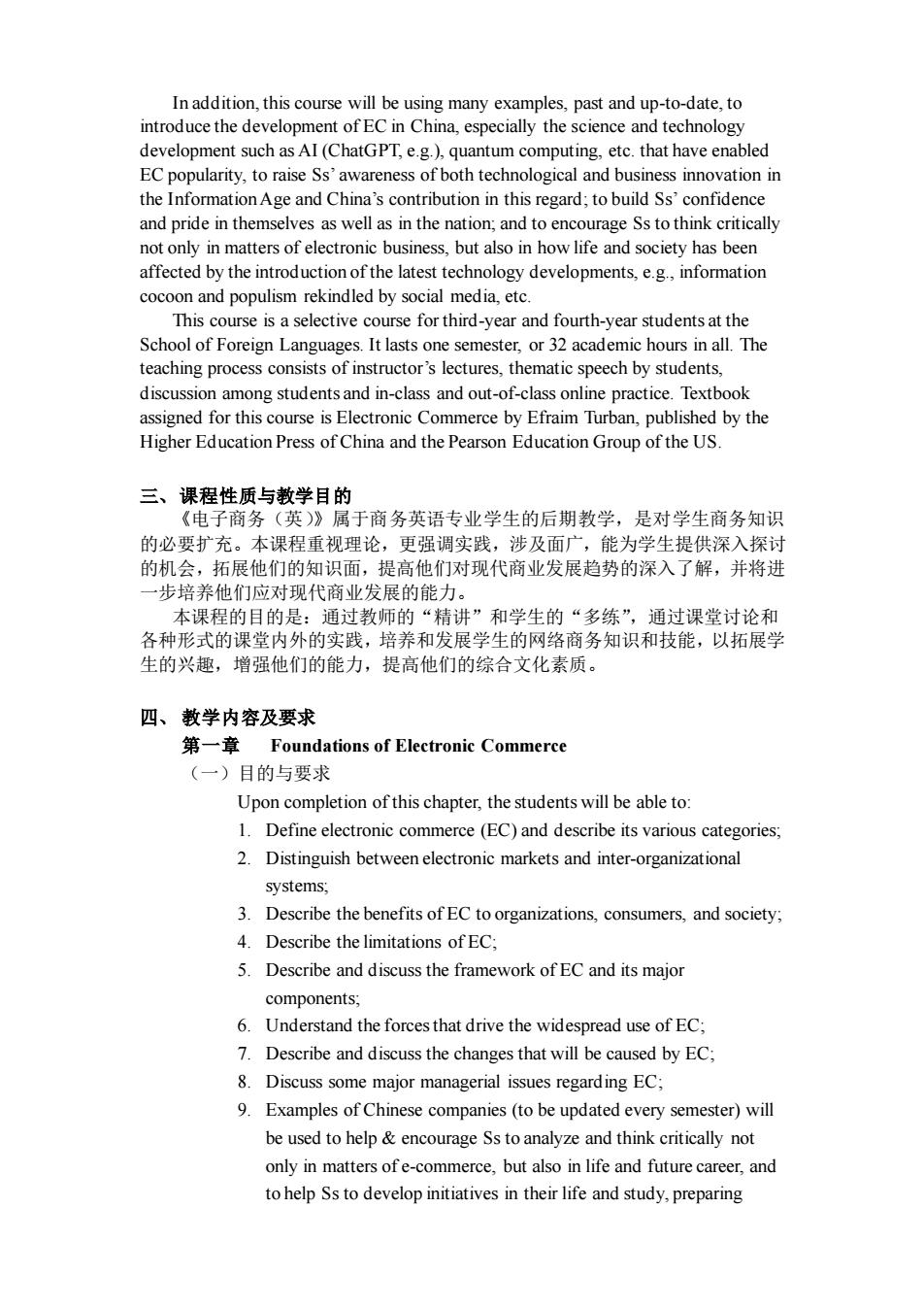
In addition,this course will be using many examples.past and up-to-date.to introduce the development of EC in China,especially the science and technology developn such asAI(ChatGPT,e.g),qu that have en bled innovation in the Information Age and China's contribution in this regard:to build Ss'confidence and pride in themselves as well as in the nation,and to encourage Ss to think critically not only in matters of electronic business.but also in how life and society has been affected by the introduction of the latest technology dev lopments,e.g. information cocoon and populism rekindled by socia media,etc This course is a selective course for third-year and fourth-year students at the School of Foreign Languages.It lasts one semester,or 32 academic hours in all.The teaching process consists of instructor's lectures,thematic speech by students, discussion among students and in-class and out-of-class online practice.Textbook course is El ctroni mmerce by Efraim Turban,published by the Higher Education Press of China and the Pearson Education Group of the US 三、课程性质与教学目 电子商务 属于商务英语专业学生的后期教学 是对学生商务知识 的必要扩充。本课程重视理论,更强调实践,涉及面广,能为学生提供深入探讨 的机会,拓展他们的知识面,提高他们对现代商业发展趋势的深入了解,并将进 一步培养他们应对现代商业发展的能力」 本课程的目的 通过教师的“精讲”和学生的“多练”,通过课堂讨论和 各种形 式的源 外的实践,培养和发展学生的网络商务知识和技能,以拓展号 生的兴趣,增强他们的能力,提高他们的综合文化素质。 四、教学内容及要求 第一章Foundations of Eleetronic Commerce (一)目的与要求 Upon completion of this chapter.the students will be able to 1.Define electronic commerce (EC)and describe its various categories: 2.Distinguish between electronic markets and inter-organizational systems; 3 Describe the benefits of ec to organizations consumers and society 4.Describe the limitations ofEC; 5.Describe and discuss the framework of EC and its majo components: 6.Understand the forces that drive the widespread use of EC: 7.Describe and discuss the changes that will be caused by EC 8.Discuss some major managerial issues regarding EC: 9.Examples of Chinese companies(to be updated every semester)will be used to help&encourage Ss toanalyze and think critically not only in matters ofe-commerce,but also in life and future career,and to help Ssto develop initiatives in their life and study,preparing
In addition, this course will be using many examples, past and up-to-date, to introduce the development of EC in China, especially the science and technology development such as AI (ChatGPT, e.g.), quantum computing, etc. that have enabled EC popularity, to raise Ss’ awareness of both technological and business innovation in the Information Age and China’s contribution in this regard; to build Ss’ confidence and pride in themselves as well as in the nation; and to encourage Ss to think critically not only in matters of electronic business, but also in how life and society has been affected by the introduction of the latest technology developments, e.g., information cocoon and populism rekindled by social media, etc. This course is a selective course for third-year and fourth-year students at the School of Foreign Languages. It lasts one semester, or 32 academic hours in all. The teaching process consists of instructor’s lectures, thematic speech by students, discussion among students and in-class and out-of-class online practice. Textbook assigned for this course is Electronic Commerce by Efraim Turban, published by the Higher Education Press of China and the Pearson Education Group of the US. 三、课程性质与教学目的 《电子商务(英)》属于商务英语专业学生的后期教学,是对学生商务知识 的必要扩充。本课程重视理论,更强调实践,涉及面广,能为学生提供深入探讨 的机会,拓展他们的知识面,提高他们对现代商业发展趋势的深入了解,并将进 一步培养他们应对现代商业发展的能力。 本课程的目的是:通过教师的“精讲”和学生的“多练”,通过课堂讨论和 各种形式的课堂内外的实践,培养和发展学生的网络商务知识和技能,以拓展学 生的兴趣,增强他们的能力,提高他们的综合文化素质。 四、 教学内容及要求 第一章 Foundations of Electronic Commerce (一)目的与要求 Upon completion of this chapter, the students will be able to: 1. Define electronic commerce (EC) and describe its various categories; 2. Distinguish between electronic markets and inter-organizational systems; 3. Describe the benefits of EC to organizations, consumers, and society; 4. Describe the limitations of EC; 5. Describe and discuss the framework of EC and its major components; 6. Understand the forces that drive the widespread use of EC; 7. Describe and discuss the changes that will be caused by EC; 8. Discuss some major managerial issues regarding EC; 9. Examples of Chinese companies (to be updated every semester) will be used to help & encourage Ss to analyze and think critically not only in matters of e-commerce, but also in life and future career, and to help Ss to develop initiatives in their life and study, preparing
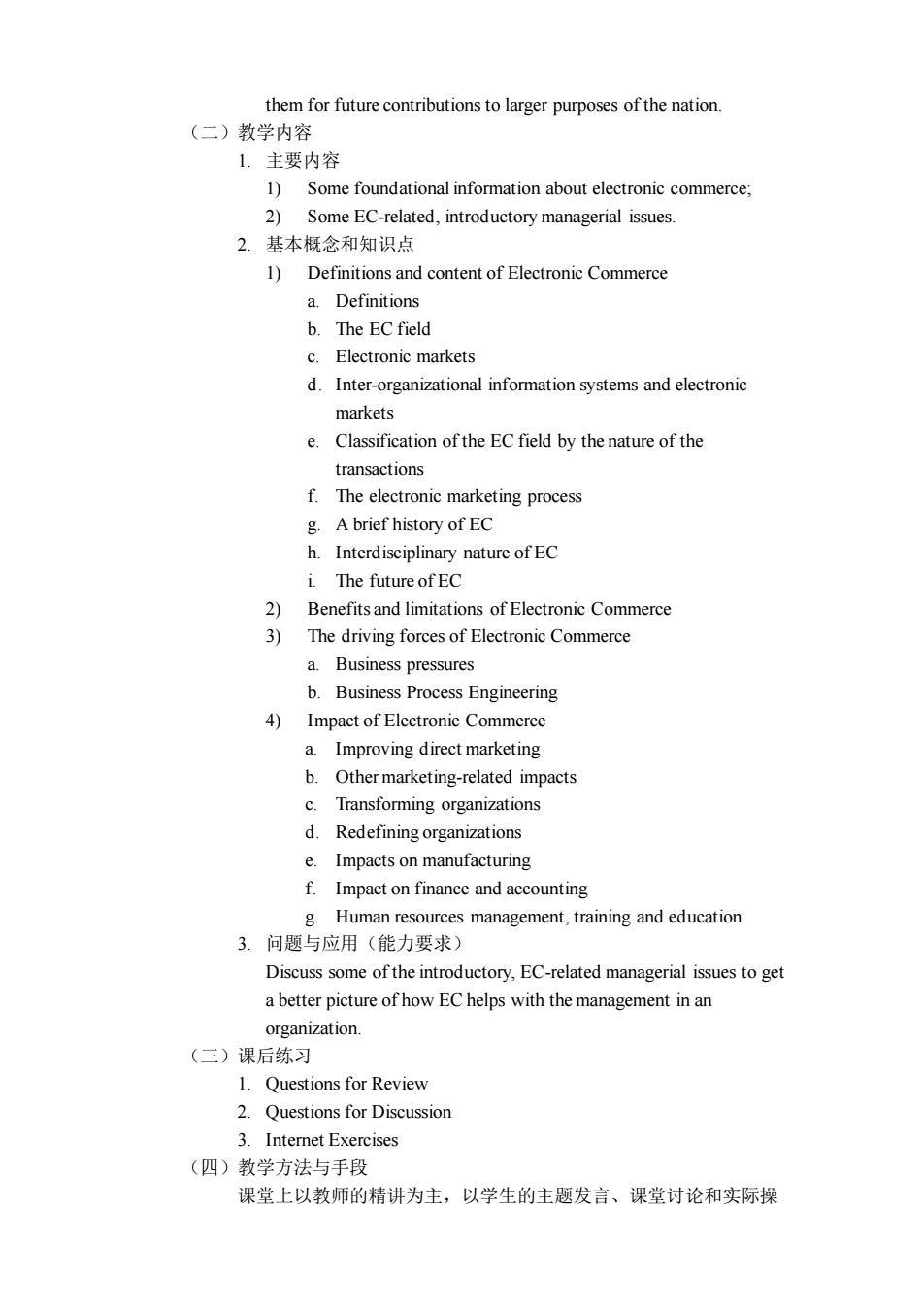
them for future contributions to larger purposes of the nation (二)教学内容 1.主要内容 1)Some foundational information about electronic commerce; 2) Some EC-related,introductory managerial issues 2.基本概念和知识点 1)Definitions and content of Electronic Commerce a Definitions b.The EC field c.Electronic markets d.Inter-organizational information systems and electronic markets e.Classification of the EC field by the nature of the transactions f.The electronic marketing process g.A brief history of EC h.Interd isciplinary nature of EC i.The future of EC 2)Benefits and limitations of Electronic Commerce 3)The driving forces of Electronic Commerce a.Business pressures b.Business Process Engineering 4)Impact of Electronic Commerce a. Improving direct marketing b.Other marketing-related impacts Transforming organizations d.Redefining organizations Impacts on manufacturing f.Impact on finance and accounting Human resources management,training and education 3.问题与应用(能力要求) Discuss some of the introductory,EC-related managerial issues to get a better picture of how EC helps with the management in an organization (三)课后练习 1.Questions for Review 2 Ouestions for Discussion 3.Internet Exercises (四)教学方法与手段 课堂上以教师的精讲为主,以学生的主题发言、课堂讨论和实际操
them for future contributions to larger purposes of the nation. (二)教学内容 1. 主要内容 1) Some foundational information about electronic commerce; 2) Some EC-related, introductory managerial issues. 2. 基本概念和知识点 1) Definitions and content of Electronic Commerce a. Definitions b. The EC field c. Electronic markets d. Inter-organizational information systems and electronic markets e. Classification of the EC field by the nature of the transactions f. The electronic marketing process g. A brief history of EC h. Interdisciplinary nature of EC i. The future of EC 2) Benefits and limitations of Electronic Commerce 3) The driving forces of Electronic Commerce a. Business pressures b. Business Process Engineering 4) Impact of Electronic Commerce a. Improving direct marketing b. Other marketing-related impacts c. Transforming organizations d. Redefining organizations e. Impacts on manufacturing f. Impact on finance and accounting g. Human resources management, training and education 3. 问题与应用(能力要求) Discuss some of the introductory, EC-related managerial issues to get a better picture of how EC helps with the management in an organization. (三)课后练习 1. Questions for Review 2. Questions for Discussion 3. Internet Exercises (四)教学方法与手段 课堂上以教师的精讲为主,以学生的主题发言、课堂讨论和实际操
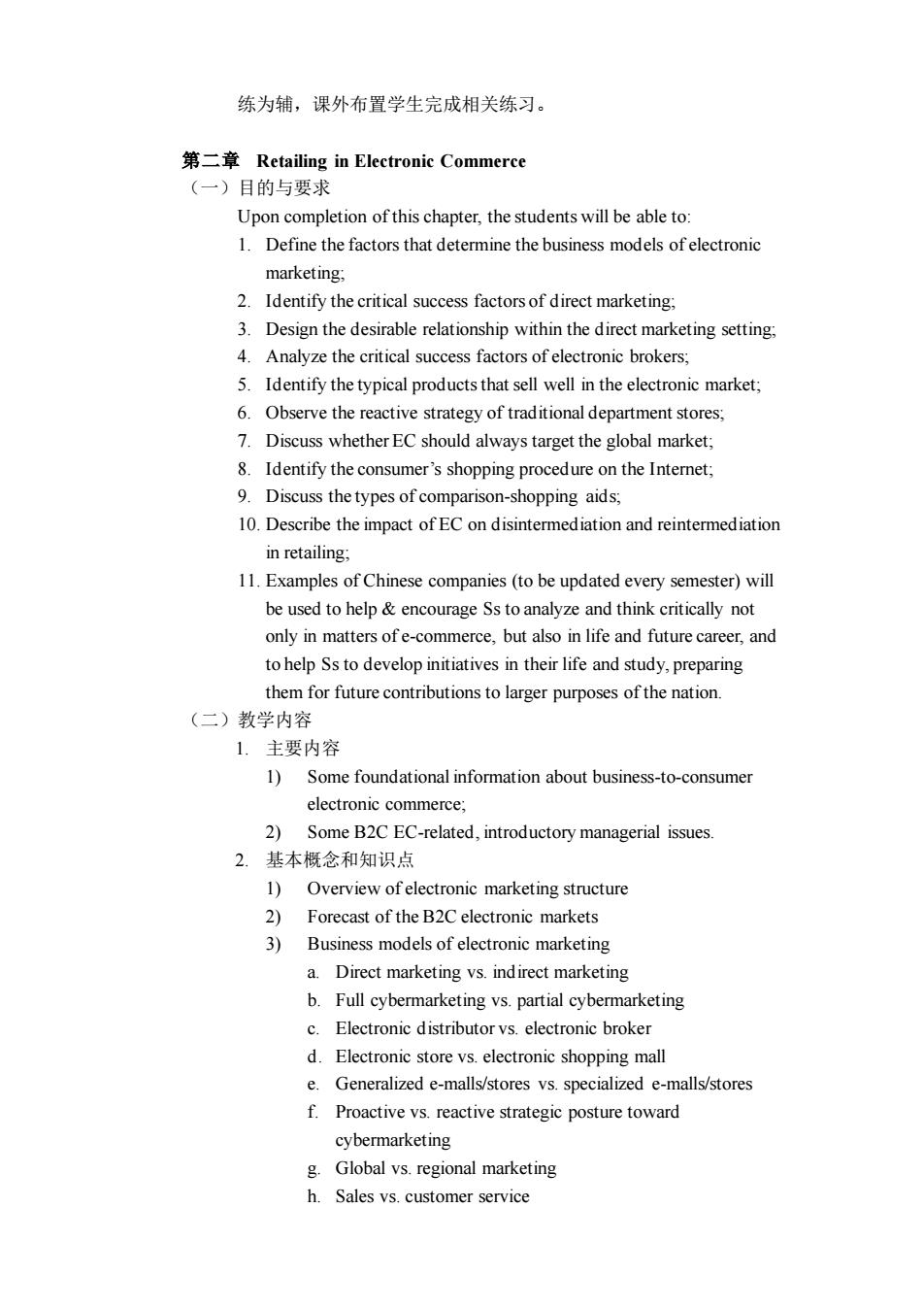
练为辅,课外布置学生完成相关练习 第二章Retailing in Electronic Commerce (一)目的与要求 Upon completion ofthis chapter,the students will be able to 1.Define the factors that determine the business models ofelectronic marketing. 2.Identify the critical success factors of direct marketing; 3.Design the desirable relationship within the direct marketing setting. 4.Analyze the critical success factors of electronic brokers; 5.Identify the typical productsthat sell well in the electronic market 6.Observe the reactive strategy of traditional department stores: 7.Discuss whether EC should always target the global market 8.Identify the consumer's shopping procedure on the Internet: 9.Discuss the types of comparison-shopping aids. 10.Describe the impact ofEC on disintermediation and reintermediation in retailing. 11.Examples of Chinese companies(to be updated every semester)will be used to help&encourage Ss to analyze and think critically not only in matters ofe-commerce,but also in life and future career,and to help Ss to develop initiatives in their life and study,preparing them for future contributions to larger purposes of the nation. (二)教学内容 1.主要内容 1)Some foundational information about business-to-consumer electronic commerce 2)Some B2C EC-related,introductory managerial issues 2.基本概念和知识点 1)Overview of electronic marketing structure 2) Forecast of the B2C electronic markets 3)Business models of electronic marketing a. Direct marketing vs.indirect marketing b.Full cybermarketing vs.partial cybermarketing c.Electronic distributor vs.electronic broker d.Electronic store vs.electronic shopping mall e Generalized e-malls/stores vs.specialized e-malls/stores f.Proactive vs.reactive strategic posture toward cybermarketing g.Global vs.regional marketing h.Sales vs.customer service
练为辅,课外布置学生完成相关练习。 第二章 Retailing in Electronic Commerce (一)目的与要求 Upon completion of this chapter, the students will be able to: 1. Define the factors that determine the business models of electronic marketing; 2. Identify the critical success factors of direct marketing; 3. Design the desirable relationship within the direct marketing setting; 4. Analyze the critical success factors of electronic brokers; 5. Identify the typical products that sell well in the electronic market; 6. Observe the reactive strategy of traditional department stores; 7. Discuss whether EC should always target the global market; 8. Identify the consumer’s shopping procedure on the Internet; 9. Discuss the types of comparison-shopping aids; 10. Describe the impact of EC on disintermediation and reintermediation in retailing; 11. Examples of Chinese companies (to be updated every semester) will be used to help & encourage Ss to analyze and think critically not only in matters of e-commerce, but also in life and future career, and to help Ss to develop initiatives in their life and study, preparing them for future contributions to larger purposes of the nation. (二)教学内容 1. 主要内容 1) Some foundational information about business-to-consumer electronic commerce; 2) Some B2C EC-related, introductory managerial issues. 2. 基本概念和知识点 1) Overview of electronic marketing structure 2) Forecast of the B2C electronic markets 3) Business models of electronic marketing a. Direct marketing vs. indirect marketing b. Full cybermarketing vs. partial cybermarketing c. Electronic distributor vs. electronic broker d. Electronic store vs. electronic shopping mall e. Generalized e-malls/stores vs. specialized e-malls/stores f. Proactive vs. reactive strategic posture toward cybermarketing g. Global vs. regional marketing h. Sales vs. customer service

4)Direct Marketing a.Proactive and full direct marketing b.Reactive and partial direct marketing 5)Online customer service 6 Electronic intermediaries a.Generalized e-brokers b.Specialized electronic distributors 7)Reactive electronic department stores 8) Regional shopping service 9)Procedure for Internet shopping:the consumer's perspective 10) Aiding comparison shopping a.Search of hypertext files by agents b.Search in a Web-based database:human and software agents sharing information c.Comparable item retrieval and tabular comparison d.Comparison of multiple items from multiple malls e.Comparison as a multiple-criteria decision making 11)The impact of EC on traditional retailing systems a.Disintermediation and reintermediation b.Impact on manufacturer's distribution strategy 3.问题与应用(能力要求) Discuss some ofthe B2C EC-related managerial issues to get a better picture of how EC helps with the management in an organization. (三)课后练习 1.Questions for Review 2.Questions for Discussion 3.Internet Exercises (四)教学方法与手段 课堂上以教师的精讲为主,以学生的主题发言、课堂讨论和实际操 练为辅,课外布置学生完成相关练习。 第三章Internet Consumers and Market Research (一)目的与要求 Upon completion of this chapter,the students will be able to: 1.Describe the essentials of consumer behavior, 1.Deseribe the characteristics of Intemet surfers and EC purchasers. 2.Understand the process of consumer purchasing decision making 3.Describe the way companies are building relationships with customers 4.Explain the implementation of customer service;
4) Direct Marketing a. Proactive and full direct marketing b. Reactive and partial direct marketing 5) Online customer service 6) Electronic intermediaries a. Generalized e-brokers b. Specialized electronic distributors 7) Reactive electronic department stores 8) Regional shopping service 9) Procedure for Internet shopping: the consumer’s perspective 10) Aiding comparison shopping a. Search of hypertext files by agents b. Search in a Web-based database: human and software agents sharing information c. Comparable item retrieval and tabular comparison d. Comparison of multiple items from multiple malls e. Comparison as a multiple-criteria decision making 11) The impact of EC on traditional retailing systems a. Disintermediation and reintermediation b. Impact on manufacturer’s distribution strategy 3. 问题与应用(能力要求) Discuss some of the B2C EC-related managerial issues to get a better picture of how EC helps with the management in an organization. (三)课后练习 1. Questions for Review 2. Questions for Discussion 3. Internet Exercises (四)教学方法与手段 课堂上以教师的精讲为主,以学生的主题发言、课堂讨论和实际操 练为辅,课外布置学生完成相关练习。 第三章 Internet Consumers and Market Research (一)目的与要求 Upon completion of this chapter, the students will be able to: 1. Describe the essentials of consumer behavior; 1. Describe the characteristics of Internet surfers and EC purchasers; 2. Understand the process of consumer purchasing decision making; 3. Describe the way companies are building relationships with customers; 4. Explain the implementation of customer service;
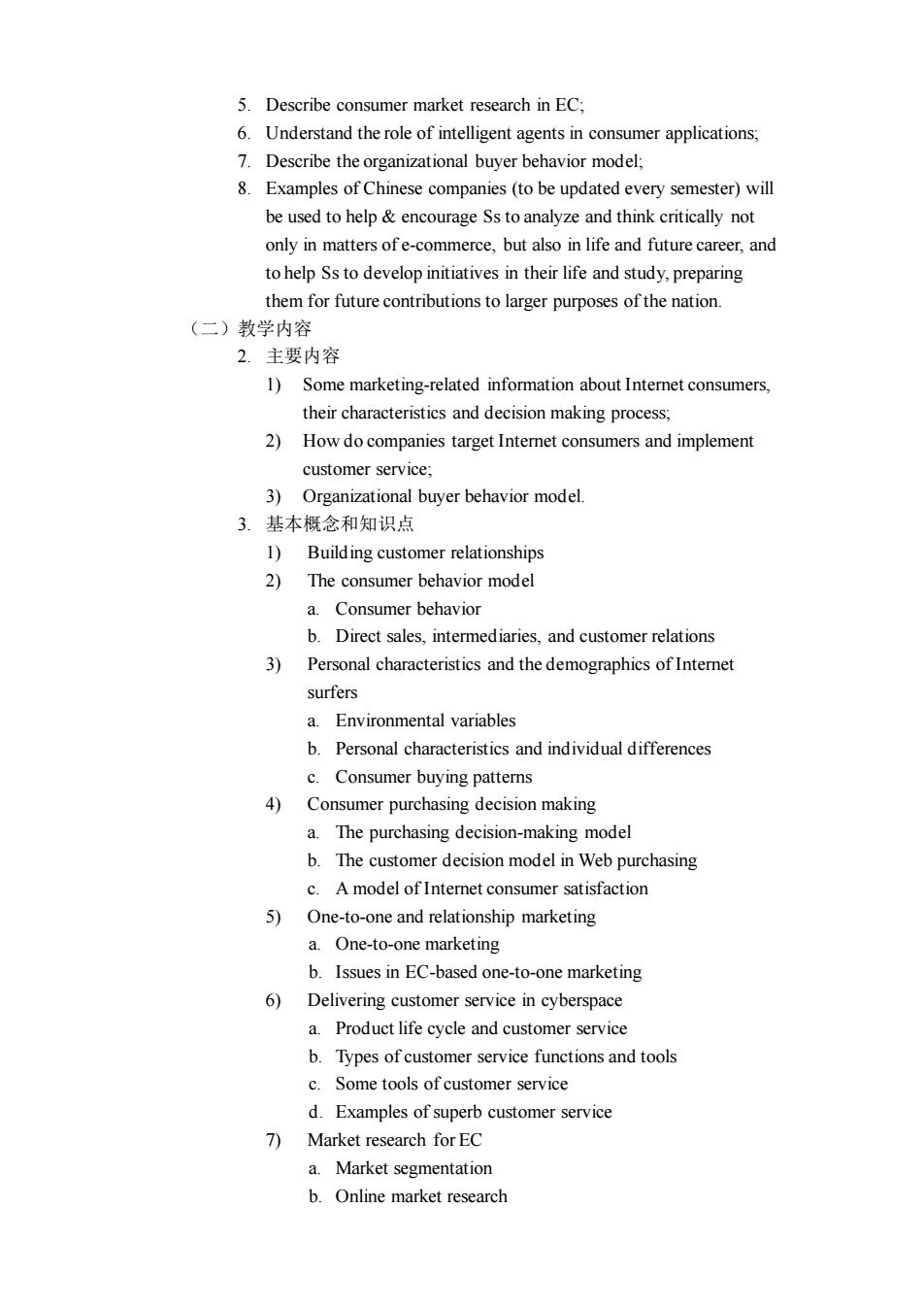
5.Describe consumer market research in EC. 6.Understand the role of intelligent agents in consumer applications, 7.Describe the organizational buyer behavior model; 8.Examples of Chinese companies (to be updated every semester)will be used to help&encourage Ss toanalyze and think critically not only in matters ofe-commerce,but also in life and future career,and tohelp Ss to develop initiatives in their life and study,preparing them for future contributions to larger purposes of the nation. (二)教学内容 2.主要内容 1)Some marketing-related information about Internet consumers their characteristics and decision making process; 2)How do companies target Internet consumers and implement customer service: 3) Organizational buyer behavior model 3.基本概念和知识点 1)Building customer relationships 2)The consumer behavior model a.Consumer behavior b.Direct sales,intermediaries,and customer relations 3)Personal characteristics and the demographics of Internet surfers a.Environmental variables b.Personal characteristics and individual differences c.Consumer buying patterns 4)Consumer purchasing decision making a.The purchasing decision-making model b.The customer decision model in Web purchasing c.A model ofInternet consumer satisfaction 5) One-to-one and relationship marketing a.One-to-one marketing b.Issues in EC-based one-to-one marketing 6)Delivering customer service in cyberspace a.Product life cycle and customer service b.Types of customer service functions and tools c.Some tools of customer service d.Examples of superb customer service Market research for EC a.Market segmentation b.Online market research
5. Describe consumer market research in EC; 6. Understand the role of intelligent agents in consumer applications; 7. Describe the organizational buyer behavior model; 8. Examples of Chinese companies (to be updated every semester) will be used to help & encourage Ss to analyze and think critically not only in matters of e-commerce, but also in life and future career, and to help Ss to develop initiatives in their life and study, preparing them for future contributions to larger purposes of the nation. (二)教学内容 2. 主要内容 1) Some marketing-related information about Internet consumers, their characteristics and decision making process; 2) How do companies target Internet consumers and implement customer service; 3) Organizational buyer behavior model. 3. 基本概念和知识点 1) Building customer relationships 2) The consumer behavior model a. Consumer behavior b. Direct sales, intermediaries, and customer relations 3) Personal characteristics and the demographics of Internet surfers a. Environmental variables b. Personal characteristics and individual differences c. Consumer buying patterns 4) Consumer purchasing decision making a. The purchasing decision-making model b. The customer decision model in Web purchasing c. A model of Internet consumer satisfaction 5) One-to-one and relationship marketing a. One-to-one marketing b. Issues in EC-based one-to-one marketing 6) Delivering customer service in cyberspace a. Product life cycle and customer service b. Types of customer service functions and tools c. Some tools of customer service d. Examples of superb customer service 7) Market research for EC a. Market segmentation b. Online market research
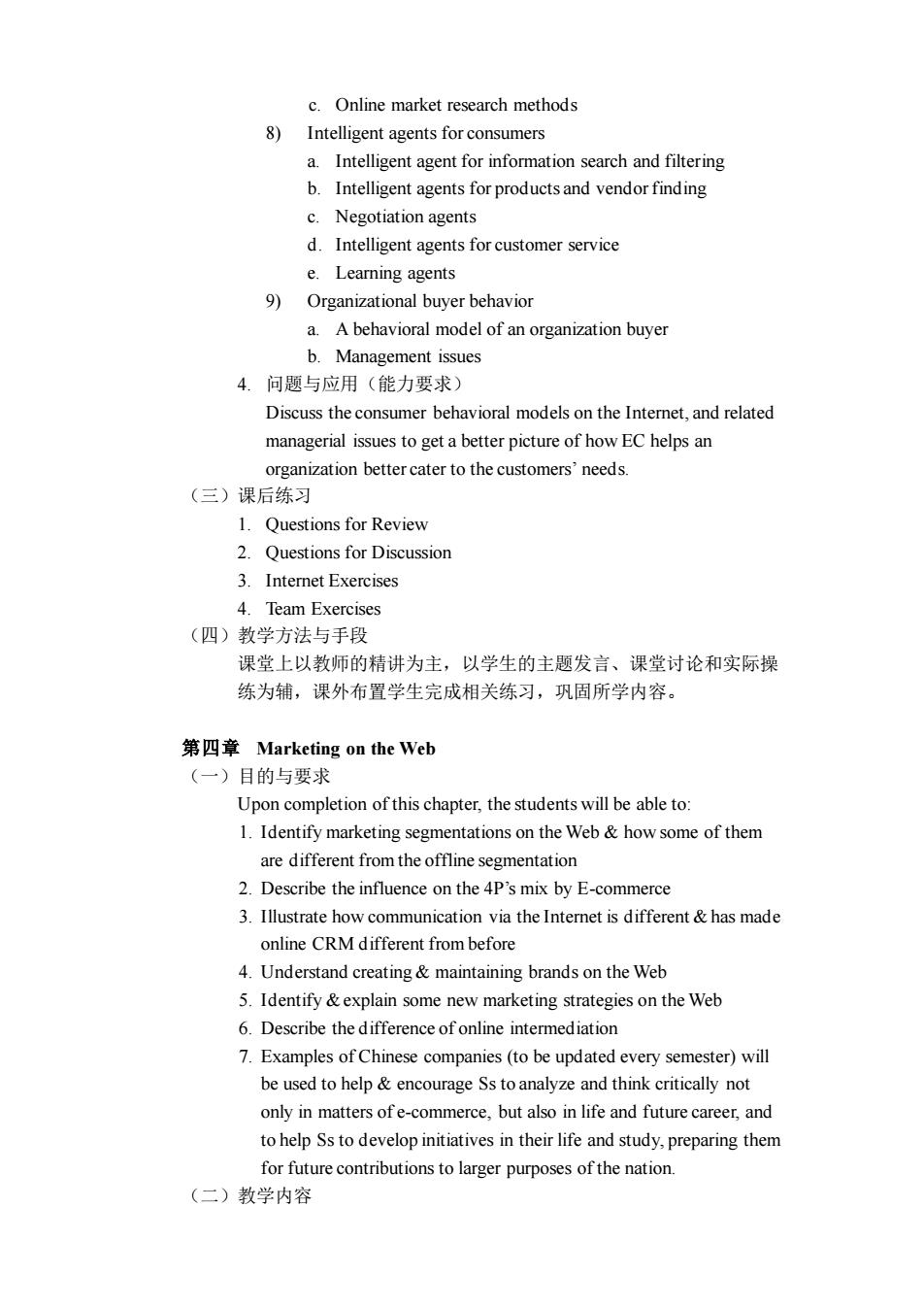
c.Online market research methods 8)Intelligent agents for consumers a.Intelligent agent for information search and filtering b.Intelligent agents for products and vendor finding c.Negotiation agents d.Intelligent agents for customer service e.Learning agents 9)Organizational buyer behavior a.A behavioral model of an organization buyer b.Management issues 4.问题与应用(能力要求) Discuss the consumer behavioral models on the Internet and related managerial issues to get a better picture of how EC helps an organization better cater to the customers'needs (三)课后练习 1.Questions for Review 2.Questions for Discussion 3.Internet Exercises 4.Team Exercises (四)教学方法与手段 课堂上以教师的精讲为主,以学生的主题发言、课堂讨论和实际操 练为辅,课外布置学生完成相关练习,巩固所学内容。 第四章Marketing on the Web (一)目的与要求 Upon completion of this chapter,the students will be able to 1.Identify marketing segmentations on the Web how some of them are different from the offline segmentation 2.Describe the influence on the 4P's mix by E-commerce 3.Illustrate how communication via the Intemnet is different&has made online CRM different from before 4.Understand creating&maintaining brands on the Web 5.Identify explain some new marketing strategies on the Web 6.Describe thedifference ofonline intermediation 7.Examples ofChinese companies(to be updated every semester)will be used to help&encourage Ss to analyze and think critically not only in matters ofe-commerce,but also in life and future career,and to help Ss to develop initiatives in their life and study,preparing them for future contributions to larger purposes of the nation. (二)教学内容
c. Online market research methods 8) Intelligent agents for consumers a. Intelligent agent for information search and filtering b. Intelligent agents for products and vendor finding c. Negotiation agents d. Intelligent agents for customer service e. Learning agents 9) Organizational buyer behavior a. A behavioral model of an organization buyer b. Management issues 4. 问题与应用(能力要求) Discuss the consumer behavioral models on the Internet, and related managerial issues to get a better picture of how EC helps an organization better cater to the customers’ needs. (三)课后练习 1. Questions for Review 2. Questions for Discussion 3. Internet Exercises 4. Team Exercises (四)教学方法与手段 课堂上以教师的精讲为主,以学生的主题发言、课堂讨论和实际操 练为辅,课外布置学生完成相关练习,巩固所学内容。 第四章 Marketing on the Web (一)目的与要求 Upon completion of this chapter, the students will be able to: 1. Identify marketing segmentations on the Web & how some of them are different from the offline segmentation 2. Describe the influence on the 4P’s mix by E-commerce 3. Illustrate how communication via the Internet is different & has made online CRM different from before 4. Understand creating & maintaining brands on the Web 5. Identify & explain some new marketing strategies on the Web 6. Describe the difference of online intermediation 7. Examples of Chinese companies (to be updated every semester) will be used to help & encourage Ss to analyze and think critically not only in matters of e-commerce, but also in life and future career, and to help Ss to develop initiatives in their life and study, preparing them for future contributions to larger purposes of the nation. (二)教学内容
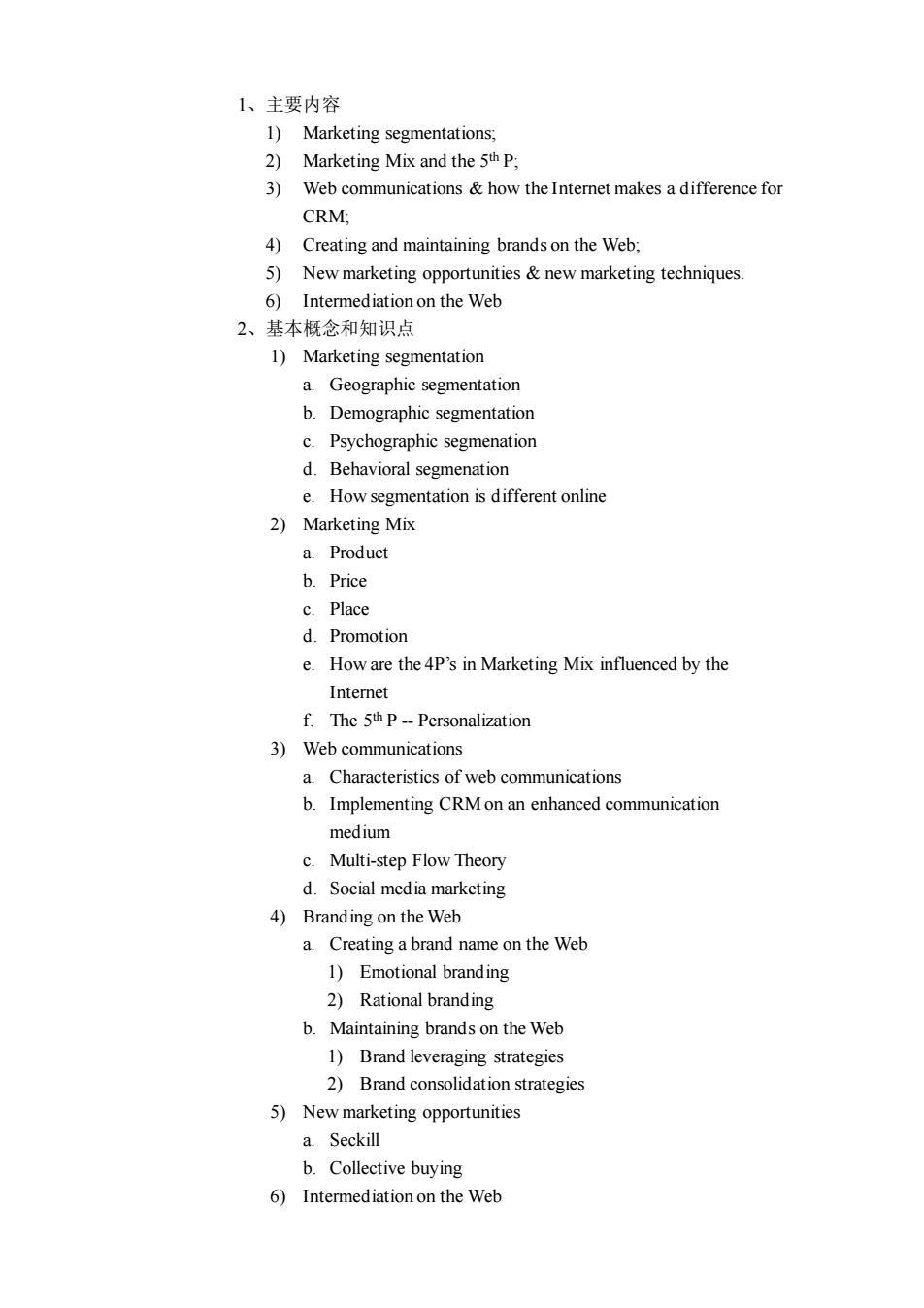
1、主要内容 1)Marketing segmentations: 2)Marketing Mix and the 5th P. 3)Web communications how the Internet makes a difference for CRM: 4)Creating and maintaining brands on the Web; 5)New marketing opportunities&new marketing techniques 6)Intermediationon the Web 2、基本概念和知识点 1)Marketing segmentation a.Geographic segmentation b.Demographic segmentation c.Psychographic segmenatior d.Behavioral segmenation e.How segmentation is different online 2)Marketing Mix a.Product b.Price c.Place d Promotion e.How are the 4P's in Marketing Mix influenced by the Internet f.The 5th P--Personalization 3)Web communications a.Characteristics of web communications b.Implementing CRMon an enhanced communication medium c.Multi-step Flow Theory d.Social media marketing 4)Branding on the Web a.Creating a brand name on the Web 1)Emotional branding 2)Rational branding b.Maintaining brands on the Web 1)Brand leveraging strategies 2)Brand consolidation strategie 5)New marketing opportunities a.Seckill b.Collective buying 6)Intermediation on the Web
1、主要内容 1) Marketing segmentations; 2) Marketing Mix and the 5th P; 3) Web communications & how the Internet makes a difference for CRM; 4) Creating and maintaining brands on the Web; 5) New marketing opportunities & new marketing techniques. 6) Intermediation on the Web 2、基本概念和知识点 1) Marketing segmentation a. Geographic segmentation b. Demographic segmentation c. Psychographic segmenation d. Behavioral segmenation e. How segmentation is different online 2) Marketing Mix a. Product b. Price c. Place d. Promotion e. How are the 4P’s in Marketing Mix influenced by the Internet f. The 5th P -- Personalization 3) Web communications a. Characteristics of web communications b. Implementing CRM on an enhanced communication medium c. Multi-step Flow Theory d. Social media marketing 4) Branding on the Web a. Creating a brand name on the Web 1) Emotional branding 2) Rational branding b. Maintaining brands on the Web 1) Brand leveraging strategies 2) Brand consolidation strategies 5) New marketing opportunities a. Seckill b. Collective buying 6) Intermediation on the Web
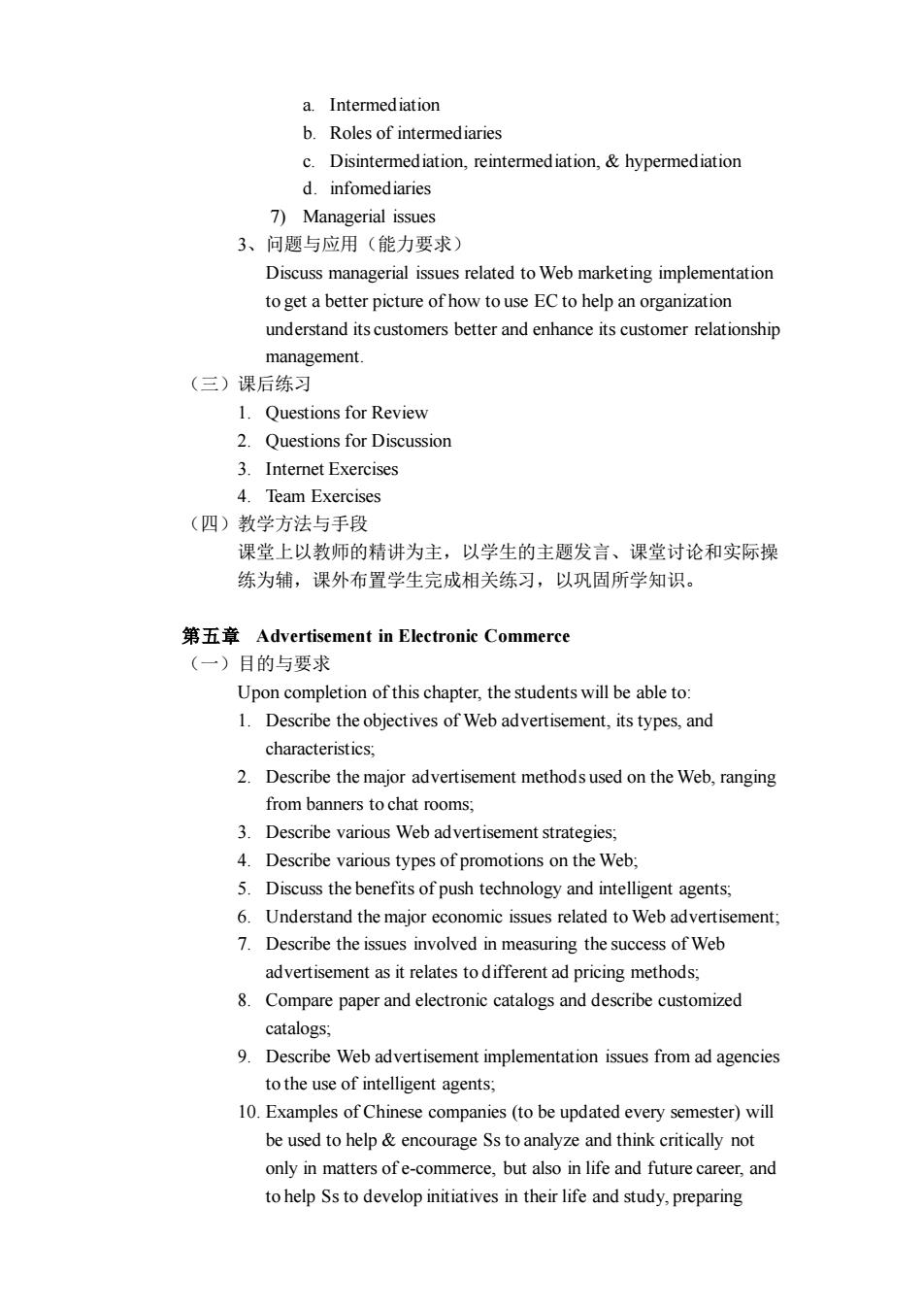
a.Intermediation b roles of intermediaries c.Disintermediation,reintermediation,&hypermediation d.infomediaries 7)Managerial issues 3、问题与应用(能力要求) Discuss managerial issues related to Web marketing implementation to get a better picture of how to use EC to help an organization understand its customers better and enhance its customer relationship management (三)课后练习 1.Ouestions for Review 2.Questions for Discussion 3.Internet Exercises 4.Team Exercises (四)教学方法与手段 课堂上以教师的精讲为主,以学生的主题发言、课堂讨论和实际操 练为铺,课外布置学牛完成相关练习,以巩周所学知识。 第五章Advertisement in Electronic Commerce (一)目的与要求 Upon completion of this chapter,the students will be able to 1.Describe the objectives of Web advertisement,its types,and characteristics. 2.Describe the major advertisement methods used on the Web,ranging from banners to chat rooms: 3.Describe various Web advertisement strategies; 4.Describe various types ofpromotions on the Web 5.Discuss the benefits of push technology and intelligent agents; 6.Understand the major economic issues related to Web advertisement 7.Describe the issues involved in measuring the success of Web advertisement as it relates todifferent ad pricing methods. 8.Compare paper and electronic catalogs and describe customized catalogs, 9.Describe web advertisement implementation issues from ad agencies tothe use of intelligent agents, 10.Examples of Chinese companies(to be updated every semester)will be used to help encourage Ss to analyze and think critically not only in matters ofe-commerce.but also in life and future career,and to help Ss to develop initiatives in their life and study.preparing
a. Intermediation b. Roles of intermediaries c. Disintermediation, reintermediation, & hypermediation d. infomediaries 7) Managerial issues 3、问题与应用(能力要求) Discuss managerial issues related to Web marketing implementation to get a better picture of how to use EC to help an organization understand its customers better and enhance its customer relationship management. (三)课后练习 1. Questions for Review 2. Questions for Discussion 3. Internet Exercises 4. Team Exercises (四)教学方法与手段 课堂上以教师的精讲为主,以学生的主题发言、课堂讨论和实际操 练为辅,课外布置学生完成相关练习,以巩固所学知识。 第五章 Advertisement in Electronic Commerce (一)目的与要求 Upon completion of this chapter, the students will be able to: 1. Describe the objectives of Web advertisement, its types, and characteristics; 2. Describe the major advertisement methods used on the Web, ranging from banners to chat rooms; 3. Describe various Web advertisement strategies; 4. Describe various types of promotions on the Web; 5. Discuss the benefits of push technology and intelligent agents; 6. Understand the major economic issues related to Web advertisement; 7. Describe the issues involved in measuring the success of Web advertisement as it relates to different ad pricing methods; 8. Compare paper and electronic catalogs and describe customized catalogs; 9. Describe Web advertisement implementation issues from ad agencies to the use of intelligent agents; 10. Examples of Chinese companies (to be updated every semester) will be used to help & encourage Ss to analyze and think critically not only in matters of e-commerce, but also in life and future career, and to help Ss to develop initiatives in their life and study, preparing
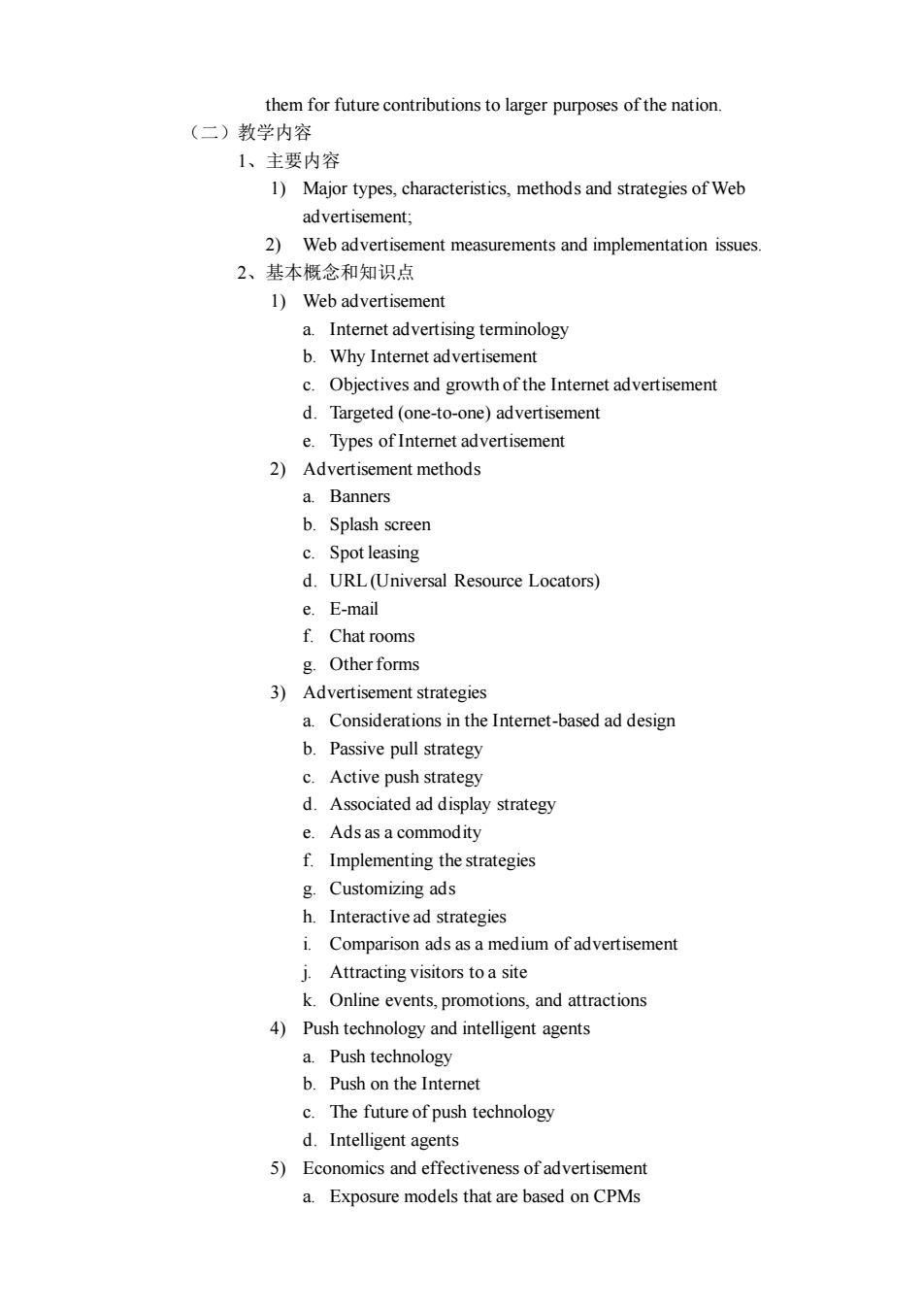
them for future contributions to larger purposes of the nation. (二)教学内容 1、主要内容 1)Major types,characteristics,methods and strategies of Web advertisement 2)Web advertisement measurements and implementation issues 2、基本概念和知识点 1)Web advertisement a.Interet advertising terminology b Why Internet advertisement c.Objectives and growth of the Internet advertisemen d.Targeted (one-to-one)advertisement 2)Advertisement methods a.Banners b.Splash screen c.Spot leasing d.Url(Universal resource locators) e.E-mail f.Chat rooms g.Other forms 3)Advertisement strategies a.Considerations in the Intemet-based ad design b.Passive pull strategy c.Active push strategy d.Associated ad display strategy e.Ads as a commodity f.Implementing the strategies g.Customizing ads h.Interactive ad strategie i.Comparison ads as a medium of advertisement Attracting visitors to a sit k.Online events,promotions,and attractions 4)Push technology and intelligent agents a.Push technology b.Push on the Internet c.The future of push technology d.Intelligent agents 5)Economics and effectiveness of advertisement a.Exposure models that are based on CPMs
them for future contributions to larger purposes of the nation. (二)教学内容 1、主要内容 1) Major types, characteristics, methods and strategies of Web advertisement; 2) Web advertisement measurements and implementation issues. 2、基本概念和知识点 1) Web advertisement a. Internet advertising terminology b. Why Internet advertisement c. Objectives and growth of the Internet advertisement d. Targeted (one-to-one) advertisement e. Types of Internet advertisement 2) Advertisement methods a. Banners b. Splash screen c. Spot leasing d. URL (Universal Resource Locators) e. E-mail f. Chat rooms g. Other forms 3) Advertisement strategies a. Considerations in the Internet-based ad design b. Passive pull strategy c. Active push strategy d. Associated ad display strategy e. Ads as a commodity f. Implementing the strategies g. Customizing ads h. Interactive ad strategies i. Comparison ads as a medium of advertisement j. Attracting visitors to a site k. Online events, promotions, and attractions 4) Push technology and intelligent agents a. Push technology b. Push on the Internet c. The future of push technology d. Intelligent agents 5) Economics and effectiveness of advertisement a. Exposure models that are based on CPMs